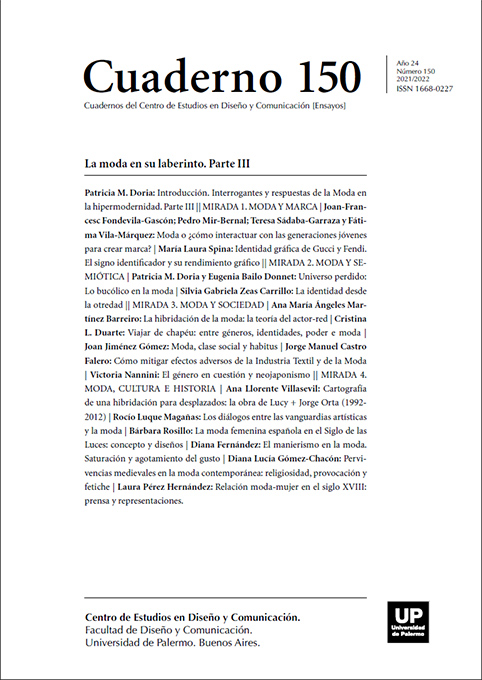Universo perdido: Lo bucólico en la moda
Abstract
The times of fashion are updated and re-invented, society reflects its states through clothing that defines the changes that go through and the social trends that interpose them. Art and fashion accompany time as a sign and symbol. They constitute the latent account of the social changes, of the manifestations, deficiencies and concerns of the reality of the world. These stories are closely related to modern life, restless, ephemeral, changing, anxious, impatient; It aims for changes as well as trends quickly. Not only in the variation of the quantitative contents of life, but also in the power acquired by the formal appeal of limits, of the beginning and the end, of arriving and leaving. The fashion system speaks of the future behaviors of society. Thus, with the emergence of Cottagecore, fashion acts as an escape to an idyllic life, an ideal world only allowed for a few.
References
Bourdieu, P. (1979). La distinción. Criterio y bases sociales del gusto. Madrid: Taurus.
Calabrese, O. (1994). La era neobarroca. Madrid: Cátedra.
De La Flor, F. R. (1983). Arcadia y Edad de Oro en la configuración bucólica. Salamanca: Biblioteca Virtual Miguel de Cervantes.
Deslandress, Y. (1998). El traje, imagen del hombre. Barcelona: Tusquets.Doria, P. (2011). Cuaderno 42. Consideraciones sobre moda, estilo y tendencia. Buenos Aires: Universidad de Palermo.
Eco, U. (2017). Historia de la Belleza. Barcelona: De Bolsillo.
Entwistle, J. (2002). El cuerpo y la Moda. Barcelona: Paidós.
Godart, F. (2012). Sociología de la Moda. Buenos Aires: Edhasa.
Gombrich, E. H. (1999). El Sentido del Orden. Barcelona: Debate.
Jones, S. R. (1985). El siglo XVIII. Universidad De Cambridge. Barcelona: Gilli.
Lipovetsky, G y Serroy, J. (2015). La estetización del mundo. Barcelona: Anagrama.
Lopez Lloret, J. (2014). Perversa Segunda Piel. Ética, Estética y Política en el vestido según Jean Jacques Rousseau. Cuaderno Dieciochistas. Salamanca: Ediciones Universidad de Salamanca.
Lurie, A. (1994). El lenguaje de la moda. Barcelona: Paidós.
Lozano, J. (2014). Simmel: La moda, el atractivo formal del límite. Madrid: Casimiro.
Nieto Caldeiro, S. (2004). Del jardín mítico al jardín del disfrute: Mesopotamia, una aproximación al origen y concepto de los jardines. Boletín del Colegio Oficial de Aparejadores y Arquitectos Técnicos de Sevilla. (66, 64).
Pelka, A. (2011). Cuadernos de la Historia Contemporánea: El significado de la moda en los sistemas dictatoriales. Una nota de semiótica histórica. Barcelona: Universitat Autònoma de Barcelona.
Popper, K. R. (1972). Objetive Knowledge. Londres: Oxford University Press.
Riviere, M. (1992). Lo cursi y el poder de la moda. Barcelona: Espasa.
Russeau, J. J. (2008). Las confesiones. Madrid: Alianza.
Russeau, J. J. (2016). Las ensoñaciones del paseante solitario. Madrid: Alianza.
Seigel, J. (2005). The Idea of the Self. Thought and Experience in Western Europe since the Seventeenth Century. Cambridge: Cambridge University Press.
Sánchez Barbero, F. (1845). Los Principios de Retórica y Poética. Madrid: Administración del Real Arbitrio de Beneficencia.
Simmel, G. (2014). Filosofía de la Moda. Madrid: Casimiro.
Volli, U. (1990). Contro la moda. Milán: Feltrinelli.
Yonnet. P. (1988). Juegos, modas y masas. Barcelona: Gedisa.
Los autores/as que publiquen en esta revista ceden los derechos de autor y de publicación a "Cuadernos del Centro de Estudios de Diseño y Comunicación", Aceptando el registro de su trabajo bajo una licencia de atribución de Creative Commons, que permite a terceros utilizar lo publicado siempre que de el crédito pertinente a los autores y a esta revista.


